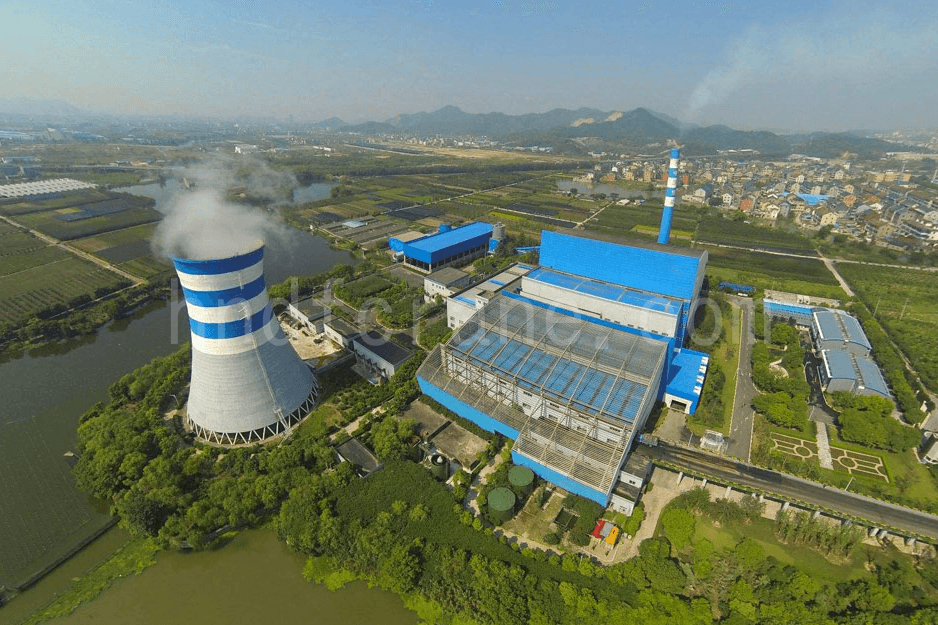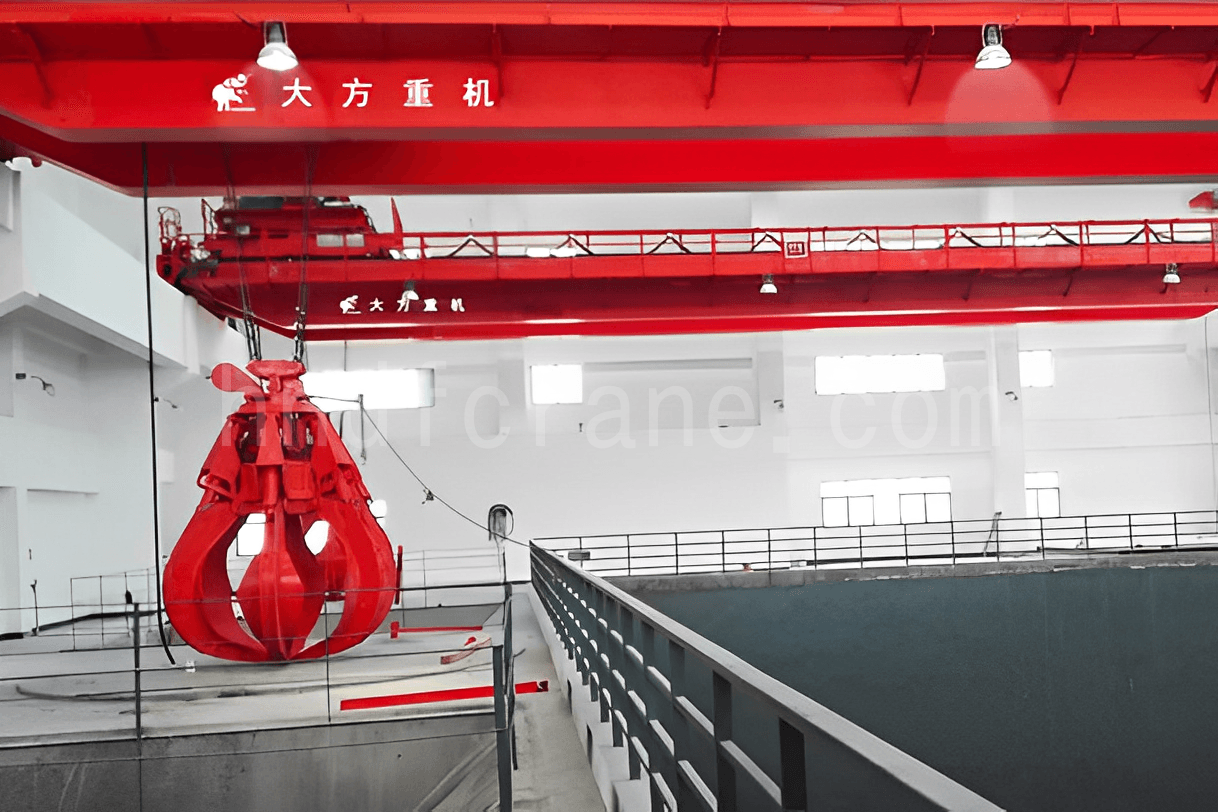Kren Overhed Loji Sisa kepada Tenaga: Panduan Konfigurasi dan Pemilihan Penting
Jadual Kandungan
Kren atas kepala memainkan peranan penting dalam loji sisa kepada tenaga, termasuk pengendalian bahan, pemasangan peralatan dan penyelenggaraan. Konfigurasi kren yang betul bukan sahaja meningkatkan kecekapan operasi loji tetapi juga memastikan keselamatan dan kestabilan dalam pengeluaran. Berdasarkan amalan kejuruteraan selama bertahun-tahun, artikel ini meneroka konfigurasi dan peranan kren overhed loji sisa kepada tenaga, memberikan cerapan berharga untuk reka bentuk dan pengendalian kemudahan tersebut di peringkat global.

I. Konfigurasi Asas Kren dalam Loji Sisa kepada Tenaga
Skala loji sisa kepada tenaga berbeza-beza dengan ketara, daripada loji kecil dengan pemprosesan satu talian 300–500 tan sehari (t/d) kepada loji besar dengan pemprosesan 4–6 talian 750–850 t/d setiap baris. Jadual 1 meringkaskan konfigurasi kren dan persediaan dalam projek sedia ada. Data ketinggian merujuk kepada ketinggian atas rel, dengan volum baldi ambil berkesan ditunjukkan dalam kurungan.
| Tidak. | Kren | Jenis Kren | Mod Pengendalian | Lokasi Pemasangan | Kapasiti Mengangkat (Grab Baldi/m³) / t | Kewajipan kerja | Kenyataan |
|---|---|---|---|---|---|---|---|
| 1 | Kren Grab Sampah | Double Girder Grab Overhed Crane | Berterusan, 24 jam/hari (24 h/d) | Tepat di atas lubang sisa, ketinggian 25–35m | 11(6.3),12.5(8),18(10),20(12) | A8 | Tidak kurang daripada dua unit, dengan satu ganti; ciri kalis letupan tidak diperlukan |
| 2 | Kren Grab Abu | Double Girder Grab Overhed Crane | Berterusan, 8~12 h/h | Tepat di atas lubang sanga, ketinggian 7–12m | 8(3.2),10(4) | A6~A8 | |
| 3 | Kren Pemasangan dan Penyelenggaraan Turbin | Kren Atas Cangkuk Girder Berganda | Selang-seli | Di dalam bilik turbin, ketinggian 13–15m | 20/5,25/5,32/5,50/10 | A3 | |
| 4 | Kren Penyelenggaraan Bilik Pam Komprehensif | Kren Underslung Electric Single Girder | Selang-seli | Di dalam bilik pam komprehensif, ketinggian 6–9m | 2~3 | A3 | |
| 5 | Kren Penyelenggaraan Sementara Fly Ash | Kren Underslung Electric Single Girder | Selang-seli | Penyelenggaraan peralatan di dalam bilik simpanan sementara abu terbang, ketinggian 6–9m | 2~3 | A3 | |
| 6 | Pengangkat Elektrik Penyelenggaraan Bengkel | Kren Underslung Electric Single Girder | Selang-seli | Di bahagian atas bengkel, ketinggian 6–8 meter | 2~5 | A3 | |
| 7 | Pengangkat Penyelenggaraan Elektrik Pengumpul Habuk Baghouse | Kren Underslung Electric Single Girder | Selang-seli | Terletak di bahagian atas pengumpul habuk baghouse | 1~3 | A3 | |
| 8 | Pengangkat Elektrik Penyelenggaraan Kren Grab Sampah | Kren Monorel Elektrik | Selang-seli | Tepat di atas kren pemungut sampah, ketinggian 32–40 meter | 3~5 | A3 | |
| 9 | Pengangkat Elektrik Penyelenggaraan Draf Draf Teraruh | Kren Monorel Elektrik | Selang-seli | Tepat di atas kipas draf teraruh, ketinggian 7–10 meter | 5~10 | A3 | |
| 10 | Pengangkat Elektrik Penyelenggaraan Pam Air Suapan | Kren Monorel Elektrik | Selang-seli | Tepat di atas pam air suapan di dalam bilik turbin, ketinggian 6-8 meter | 3~5 | A3 | |
| 11 | Pengangkat Elektrik Penyelenggaraan Kipas Udara Utama | Kren Monorel Elektrik | Selang-seli | Tepat di atas kipas udara utama di bengkel pembakaran, ketinggian 6–8 meter | 2~5 | A3 | |
| 12 | Pengangkat Elektrik Penyelenggaraan Bilik Pemampat | Kren Monorel Elektrik | Selang-seli | Di bahagian atas bilik pemampat, ketinggian 6–8 meter | 1~3 | A3 | |
| 13 | Pengangkat Elektrik Penyelenggaraan Atas Dandang | Kren Monorel Elektrik | Selang-seli | Di bahagian atas dandang, di atas ketinggian galang dandang utama | 2~5 | A3 | |
| 14 | Deacidification Tower Top Electric Maintenance Hoist | Kren Monorel Elektrik | Selang-seli | Di atas ketinggian puncak menara penyahasidan | 1~3 | A3 | |
| 15 | Pengangkat Elektrik Penyelenggaraan Pam Leachate | Kren Monorel Elektrik | Selang-seli | Di atas tangki larut lesap, ketinggian -2 hingga -5 meter | 1~3 | A3 | Persediaan kalis letupan diperlukan |
Jadual 1: Parameter Teknikal Utama Kren dalam Loji Sisa-ke-Tenaga
II. Fungsi dan Konfigurasi Pelbagai Kren
Double Girder Grab Overhed Crane
(1) Kren Pengendalian Sisa

Fungsi daripada kren pengendalian sisa adalah untuk merebut, melonggok, membuang, dan memberi makan sisa di dalam lubang sisa. Ia dipasang di atas lubang buangan, dengan titik rampas yang paling rendah sekurang-kurangnya 2 meter dari paras corong makanan sisa. Bilik kawalan kren pemungut sampah terletak sama ada bertentangan atau di tepi corong sisa. Kren sampah dan insinerator mesti beroperasi serentak untuk memastikan operasi loji pembakaran yang selamat dan stabil; jika tidak, ia akan mengganggu suapan kepada insinerator, yang berpotensi menyebabkan penutupan keseluruhan loji. Oleh itu, kren pelupusan sampah ialah peralatan teras dalam loji pembakaran, yang memerlukan ketepatan, kestabilan dan kebolehpercayaan yang sangat tinggi. Kelas tugasnya mesti memenuhi piawaian A8 dan harus dikonfigurasikan dengan satu unit aktif dan satu siap sedia.
Selain itu, mengambil kira persekitaran yang keras (cth, lembap, berasid, mengandungi gas berbahaya seperti CH4 dan H2S), adalah penting untuk menggunakan komponen matang dan stabil untuk cengkaman, sistem hidraulik dan komponen elektrik. Berdasarkan pengalaman operasi selama bertahun-tahun, kepekatan gas mudah terbakar dan meletup di kawasan tempat kren pengendalian sisa beroperasi secara amnya tidak tinggi, dan dalam kebanyakan kes, tetapan kalis letupan tidak diperlukan.
(2) Kren Grab Abu
Fungsi kren ash grab adalah untuk memindahkan sanga yang dilepaskan dari insinerator ke kenderaan pengangkutan. Berbanding dengan kren ambil sampah, keperluan prestasi untuk kren ambil abu adalah lebih rendah, kerana ia tidak perlu beroperasi selari dengan insinerator. Memandangkan jumlah terhad lubang sanga, adalah dikehendaki masa maksimum untuk menyelesaikan sebarang kesalahan dalam lubang sanga tidak boleh melebihi satu hari. Bilik kawalan untuk kren ambil abu biasanya terletak di tepi atau di hujung lubang sanga, dan beberapa loji pembakaran menggunakan alat kawalan jauh untuk operasi.
Kelas tugas kren ambil abu secara amnya lebih rendah daripada kren ambil sampah, dengan A6 adalah mencukupi. Walau bagaimanapun, konfigurasi sebenar unit dan bekas simpanan sanga juga perlu dipertimbangkan. Secara amnya, loji insinerasi dengan lebih daripada dua talian insinerasi harus menggunakan kelas tugas A7 atau A8. Untuk loji insinerasi besar dengan empat garisan insinerasi, memandangkan lebar kawasan penyimpanan sanga yang besar, dua kren ambil abu harus digunakan.
Kren Overhed Double Girder

The kren atas galang dua merujuk kepada kren pemasangan dan penyelenggaraan turbin (selepas ini dirujuk sebagai kren turbin). Fungsi utamanya ialah pemasangan dan penyelenggaraan turbin dan penjana. Tidak seperti kren pemungut sampah dan kren pemungut abu, kren turbin hanya digunakan selepas loji beroperasi. Oleh kerana saiz dan jisim unit penjana turbin yang besar, ia biasanya diangkut ke loji sisa kepada tenaga di bahagian yang berasingan daripada kemudahan pembuatan. Kren turbin kemudiannya digunakan untuk mengangkat dan memasang komponen turbin dan penjana. Selepas pemasangan, kren turbin mesti digunakan dengan kerap untuk penyelenggaraan dan pemeriksaan turbin dan penjana. Kren perlu beroperasi pada kapasiti penuh sekurang-kurangnya dua kali setahun (2 kali/a).
Kren Underslung Electric Single Girder
Kren bawah galang tunggal elektrik bertanggungjawab terutamanya untuk penyelenggaraan dan pemeriksaan bilik pam komprehensif, bilik simpanan sementara abu terbang, bengkel, dan pengumpul habuk baghouse itu sendiri. Reka bentuk bilik ini memerlukan angkat mempunyai fungsi mengangkat, troli dan pergerakan kren. Contohnya, dalam pengumpul habuk rumah beg, komponen seperti pembersih abu dan sangkar beg perlu diangkat dan diletakkan di seluruh permukaan kerja. Pengangkat mesti boleh mencapai semua kawasan ruang kerja, dan pengangkat penyelenggaraan hendaklah digunakan sekurang-kurangnya dua kali setahun (2 kali/a).
Kren Monorel Elektrik
Jejak elektrik kren monorel adalah agak mudah, dan ia digunakan terutamanya untuk mengangkat dan mengangkut peralatan berat tetap seperti kipas, pam, dan jentera berputar lain. Kapasiti angkat maksimum tidak lebih daripada 10 tan, dengan kebanyakannya memerlukan pergerakan di sepanjang trek satu arah, manakala beberapa hanya memerlukan fungsi mengangkat. Adalah penting untuk ambil perhatian bahawa di sesetengah kawasan, mungkin terdapat gas mudah terbakar dan meletup seperti H2S, CO dan NH3, memerlukan penggunaan motor kalis letupan.
III. Kaedah Pemilihan Kren untuk Loji Sisa kepada Tenaga
Dalam loji sisa kepada tenaga, terdapat beberapa set kren, setiap satu berbeza dengan ketara dalam jenis, kapasiti mengangkat, keperluan teknikal dan susun atur. Item 1 hingga 3 dalam Jadual 1 secara amnya mewakili konfigurasi piawai untuk loji sisa kepada tenaga, manakala peralatan lain ditentukan berdasarkan skala loji, konfigurasi peralatan dan keperluan pemilik.
Kren boleh dibahagikan kepada peralatan operasi dan peralatan penyelenggaraan mengikut fungsinya. Kedua-dua kren pemungut sampah dan kren pemungut abu berada di bawah peralatan operasi, yang memerlukan waktu operasi harian. Khususnya, kren pemungut sampah mesti beroperasi secara berterusan dengan ketepatan dan kestabilan, dan sekurang-kurangnya dua set kren diperlukan. Kebanyakan projek juga memerlukan kren ambil siap sedia tambahan untuk memastikan operasi tidak terhenti akibat kerosakan pada kren ambil sampah. Kren penyelenggaraan kurang kerap digunakan, dan keperluan persekitarannya berbeza-beza.
(1) Kapasiti angkat maksimum kren pemungut sampah ditentukan oleh konfigurasi unit projek, kapasiti pemprosesan, dan susun atur lubang sisa. Berdasarkan reka bentuk projek sebelum ini, kapasiti angkat dan volum baldi ambil untuk kren ambil sampah dan kren ambil abu diringkaskan dalam jadual di bawah.
| Skala Pemprosesan | Kren Sampah / Kren Abu | |||
|---|---|---|---|---|
| Jumlah Kapasiti Pemprosesan (t/d) | Bilangan Talian Pembakaran | Kapasiti Mengangkat (t) | Grab Baldi Isipadu (m³) | Bilangan Unit |
| ≤600 | ≤2 | 11/8 | 6.3/3.2 | 2/1 |
| 600 | ≤3 | 12.5/8 | 8/3.2 | 2/1atau2 |
| 1200 | 2≤garisan insinerasi≤3 | 18/8 | 10/3.2 | 2/2 |
| 1800 | 2≤garisan insinerasi≤4 | 18/10 | 10/4 | 3/2 |
| 2400 | ≤4 | 18/10 | 10/4 | 4/2 |
| 2400 | ≤4 | 20/10 | 12/4 | 3/2 |
(2) Kapasiti angkat kren turbin adalah berkaitan dengan berat maksimum satu komponen semasa memunggah dan memasang penjana. Berdasarkan pengalaman terkumpul, untuk unit sisa kepada tenaga dengan kapasiti di bawah 30 MW dan kurang daripada 3 unit, kren turbin tunggal biasanya dipilih. Apabila bilangan unit adalah sama dengan atau melebihi 3, mungkin dinasihatkan untuk memilih dua kren turbin (satu besar dan satu kecil).
(3) Keupayaan mengangkat kren penyelenggaraan lain (item 4–15 dalam Jadual 1) bergantung pada berat maksimum peralatan yang diservis. Faktor-faktor yang dipertimbangkan semasa menentukan keperluan untuk angkat berbeza-beza:
- Berat maksimum kipas udara primer dan kipas draf teraruh berkait rapat dengan kapasiti pemprosesan setiap relau. Ini kerana insinerator dan kipas beroperasi pada asas satu sama satu—semakin besar kapasiti pemprosesan satu insinerator, semakin besar keperluan udara dan ekzos, yang seterusnya meningkatkan saiz dan berat peralatan kipas. Berdasarkan pengalaman projek kejuruteraan, adalah disyorkan untuk memasang angkat penyelenggaraan untuk kipas draf utama dan teraruh yang dikaitkan dengan pemprosesan insinerator lebih daripada 600 t/d.
- Keperluan untuk pengangkat penyelenggaraan untuk pam air suapan dan pemampat tidak berkaitan secara langsung dengan kapasiti pemprosesan. Keputusan adalah berdasarkan berat maksimum peralatan.
- Pengangkat lain, seperti untuk menara penyahasidan, pengumpul habuk, dan bahagian atas dandang, selalunya diletakkan pada ketinggian yang tinggi untuk mengelakkan terjatuh dan memastikan keselamatan pekerja.
- Pam larut lesap terletak di dalam ruang tertutup yang dipenuhi dengan kelembapan, haba dan gas berbahaya, menjadikan penambahan angkat penyelenggaraan membantu dalam mengurangkan beban kerja dan meningkatkan keselamatan untuk kakitangan penyelenggaraan.
Secara umum, konfigurasi kren penyelenggaraan dalam julat ini adalah serupa dengan loji industri lain (seperti loji rawatan air sisa, loji janakuasa haba, loji kimia dan kilang keluli). Matlamat utama adalah untuk memenuhi keperluan penyelenggaraan peralatan, meminimumkan masa penyelenggaraan, dan mengurangkan intensiti buruh. Apabila memilih kren kecil untuk aplikasi ini, ciri-ciri loji sisa kepada tenaga tidak menjejaskan pilihan kren dengan ketara. Jurutera boleh mengkonfigurasi kren mengikut piawaian negara atau industri yang berkaitan dan keadaan tapak.
Rujukan: Konfigurasi Kren Loji Sisa kepada Tenaga
Hantar Pertanyaan Anda
- e-mel: sales@hndfcrane.com
- WhatsApp: +86-191 3738 6654
- Tel: +86-373-581 8299
- Faks: +86-373-215 7000
- Tambah: Daerah Perindustrian Changnao, Bandar Xinxiang, Wilayah Henan, China








































































